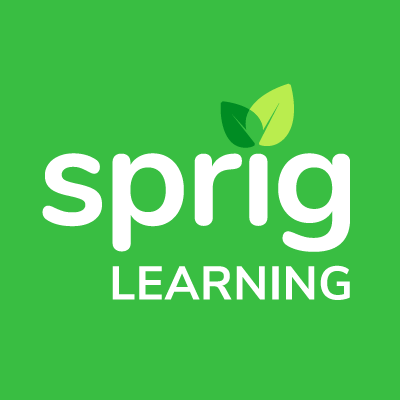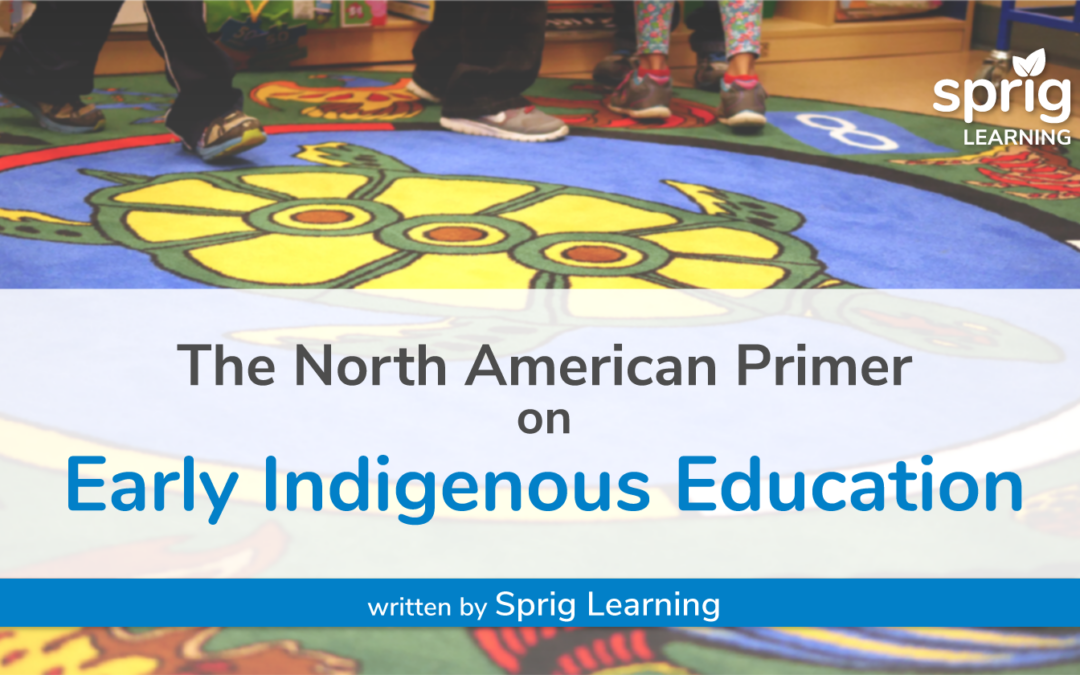Indigenous Education and Sprig
Sprig Learning is a purpose-built company that focuses on holistic early learning pedagogy and approaches that ensures every student receives a fair shot at success in school. Education inequity can rear its head in many shapes and forms across schools and classrooms in North America. In all of our educational programming, we strive to address both socio-economic and cultural inequities as much as possible.
Since 2018, Sprig Learning and Mi’kmaw Kina’matnewey have worked in partnership to create innovative education technology resources for Mi’kmaw students, teachers, and families across Nova Scotia. We have dedicated a Language Revitalization page on our website that provides Indigenous educational resources which support the local curriculum. It helps to collectively pause and reflect back on the nature of Indigenous education, so together we can better support all Indigenous students, families and communities.
What is Indigenous Education?

It’s best to start by defining what is meant by Indigenous education. Awareness of Indigenous matters is rising across North America, but there is definitely a long way to go before there is true understanding and reconciliation.
Indigenous educators identify several key attributes of Indigenous education. Indigenous education is a lifelong process that is experiential in nature and rooted in Indigenous languages and cultures. Indigenous education is an integration of both Indigenous and Western knowledge, it is spiritually oriented, and a communal activity that involves family, community and Elders.
To truly understand Indigenous education, the historical context must be understood and reconciled. In the not-so-distant past in both the US and Canada, boarding schools and residential schools were used to assimilate Indigenous children into mainstream society. These social policies ultimately failed and were rightly disbanded. Indigenous cultures and languages are alive today across numerous nations, communities, tribes and language families. But the impact of residential schools is real and devastating. Impacting the important tenets of Indigenous education: language, culture, community, traditions, and relationships.
As the former Indigenous Supreme Court Judge and senate member, Honourable Murray Sinclair aptly said, “Education has gotten us into this mess, and education will get us out.” This message is especially important in early childhood education, where foundational learning occurs which significantly determines the success of students in later years.
Indigenous control over Indigenous education is pivotal to this change. Increasingly, Indigenous communities are administering educational programs and services formerly delivered by non-Indigenous governments. Indigenous communities, schools, and education systems are developing culturally relevant curriculum and community-based language and culture programs and creating their own educational institutions.
However, full control of Indigenous education has far from been realized. Today in the USA, the Bureau of Indian Education (BIE) funds 183 elementary and secondary schools for Indigenous students, 130 of which are tribally controlled. Approximately 95% of American Indian and Alaskan Native students attend public schools, and only 17% of those students attend schools where the majority of students are Indigenous.
Indigenous research, scholars and educators have long identified that educational outcomes improve when Indigenous communities and schools lead and control their education system. An Indigenous education system that is holistic, lifelong, grounded in Indigenous language and culture, and community-led.
Why is Indigenous Education Important?
Indigenous education has come to the forefront of the education dialogue recently in North America. There is a growing understanding of the importance of Indigenous education and its benefit for all students. Increased awareness and understanding of Indigenous peoples, customs, traditions and cultures helps improve the quality of public education overall, adding depth and innovation to the curriculum across all ages.
There is also much that public education systems can learn from Indigenous pedagogies and approaches. For instance, an Indigenous focus on holistic education, which covers not just intellectual development, but also physical, spiritual and emotional development, allows for more comprehensive support for all learners. In public education, social-emotional learning is often treated as a separate domain. But in Indigenous education, it is inclusive and part of the holistic approach.
Indigenous learning practices incorporate learning by doing. Experiential learning supports informal and formal education where students engage in place-based activities in the classroom or outside on the land. For example, Indigenous learners in Alaska use all five senses to learn, and are also taught to use their gut feeling or intuition.
Indigenous education also places special value on the land and climate. Learning about these things at an early age develops a more holistic consciousness and supports the promotion of ecological sustainability in the long run.
Incorporating Indigenous ways of knowing and learning into classrooms can also help rectify any false narratives and stereotypes created over the years about Indigenous peoples.
Focus on Indigenous Sovereignty
According to Indigenous educators and leaders all around North America, the most important value of Indigenous education is its role in the further development of Indigenous pedagogy. Both the US and Canada have schools on reservations that have some degree of autonomy to set their curriculum and teaching methods.
John Martin, Chief of Gesapegiag called the recent memorandum of understanding to develop a regional education agreement as “one more step toward the common achievement of change that fully supports the control of First Nations’s education by and for First Nations in Quebec, as envisioned by Chiefs in the early 1970s”.
The continued advocacy of Indigenous education creates the momentum and urgency for government bodies, concerned institutions and also the private sector to invest in the development of Indigenous resources and professional development.
What Are the Challenges Surrounding Indigenous Education?

The importance of Indigenous education is well established by identifying its strengths, benefits and general sentiments from those in the community. But there is another way to understand just how much of an impact, policies, investments and innovation have on Indigenous education. It’s by looking at what happens when there is the absence of the aforementioned three factors.
Indigenous school children have historically faced isolation, self-doubt and confusion when trying to conform to a system that does not acknowledge their culture and traditions. Further to this, the median annual household income for Indigenous Americans in the US is only $23,000. For those living on reserve, the lower range of this number can drop down to as low as $5,000. Household income levels for Indigenous peoples are not much better in Canada where almost half of the registered First Nations population living on reservations were in a low-income situation in the last census.
So, when combined with the threat of acculturation and poverty, Indigenous students on a whole have not succeeded in school as early learners. Families find it challenging to support their child’s learning at school and at home. Schools are often not resourced adequately to provide the individual attention every child deserves. All coupled with a historic bias (implicit and explicit) in the education system that impacts the success of Indigenous learners.
When it comes to the teaching provided in the schools, Indigenous students have historically reported experiencing minimal individual attention and personal contact with their teachers. This sense of neglect more often leads to a feeling of disconnect, where there is lack of motivation to attend school and learn.
What Is Being Done to Support Indigenous Education?

Things are slowly beginning to improve as Indigenous educators and advocacy groups push for legislative changes that incorporate Indigenous education across the curriculum. But its implementation is patchy across the board, with some jurisdictions not requiring the provision of some Indigenous concepts in the curriculum, and some requiring its implementation at some level.
Indigenous sovereignty and control over education is not fully realized in all jurisdictions. Yet we should look to celebrate the many successes, including amalgamations of Indigenous knowledge into the curriculum that have been localized.
- Arizona has developed an Apache language immersion program and drumming to promote Apache culture and pride.
- Montana introduced Indigenous history material that explains the current state of the reservations and how historical treaties and acts played a role in it.
- Washington incorporated elements of Indigenous sciences for its Spokane student body, such as using a traditional menthol-flavored root to soothe throats.
There are capacity-building laws being introduced to support Indigenous education in the US. New Mexico legislature’s Derrick Lente says “it’s not a higher education bill, rather it’s leveraging those folks in higher education capacities to help our students and our tribal communities to develop their own curricula within their own communities”.
In Canada, the importance of building a quality Indigenous curriculum is reflected in many federal programs and commissions. For example, The Indigenous Early Learning and Child Care Framework was set up to provide a “comprehensive and coordinated system that is anchored in self-determination, centered on children and grounded in culture”.
In a survey of First Nations, Inuit and Métis in Canada, the importance of language, culture and history were the top responses from participants in all regions. Both Indigenous parents and youth alike expressed the desire to include more of these themes in the school curriculum.
Great consideration is being given to early learning in primary grades as well to avoid the classroom alienation many Indigenous students have felt about their history and culture. The revitalization of language is a core concept where Indigenous students should feel proud to express and retain their culture.
There are a host of other challenges that impact Indigenous education, such as school infrastructure, teacher training, extracurricular services, and community support. To date, language and classroom curriculum improvements seem to be the fountainhead for most improvements.
Only the Beginning
Indigenous education is a full-fledged system of its own that holistically embraces the mental, physical, emotional and spiritual aspects of learning, with a special focus on community involvement and learning from Elders. There is so much commonality between an Indigenous approach to learning and early childhood pedagogy. This is why, at Sprig, holistic learning is one of the key tenets of our company.
But from a grand scheme of things, Indigenous education in North America requires much more attention. We hope this discussion contributed to the understanding and needed discussion for all Indigenous students, schools and communities.

